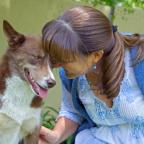
Vets Autumn warning as new seasonal dangers arise for pets
Autumn is upon us! It's the season for muddy woodland walks and enjoying the delights this time of year has to offer.
Although autumn can be beautiful, it's important to be aware of the seasonal dangers that could be harmful to your pet. PDSA's vet team shares some key things to watch out for:
Blue-green algae
The opportunity to splash around can be hard for any pet to resist but don't forget to be cautious of blue-green algae in early autumn. More prominent in warmer weather, blue-green algae is highly toxic to pets and can quickly become fatal, so if you see a blue-green layer on any body of water, avoid it entirely. Muddy, stagnant puddles or ponds can also give your pet a stomach upset, so it's best to avoid these too.
Seasonal Canine Illness
Seasonal Canine Illness (SCI) or may be referred to as 'Canine Seasonal Disease' is a little-known condition that typically affects dogs in the autumn. The symptoms are also typical of gastrointestinal upsets and other health conditions, so it isn't always clear if a dog has seasonal canine illness. The symptoms to look out for are vomiting, diarrhoea, lethargy, fever, muscle tremors and abdominal pain, and they will usually appear in dogs between one and three days after being walked in a wooded area.
Harvest mites
Harvest mites (Neotrombicula autumnalis) are tiny, bright orange mites that live in soil. They are common in woodland and grassy areas, and are most active during the late summer and autumn. Harvest mites will attach to, and feed from any animal that they come into contact with, including dogs.
If your dog picks up a harvest mite infestation, they will become itchy and uncomfortable. Some dogs are extremely sensitive to harvest mite saliva and develop intensely itchy, red, inflamed skin where they've been bitten. Infestations are most common in between toes, on the feet, legs, armpits, genitals, tummy, and can occasionally affect the ears.
Poisonous plants
Conkers and acorns can be great for your autumn crafts, but they are toxic to dogs – serious cases of poisoning are rare, but they can cause stomach problems, vomiting and intestinal blockages.
Fungi and mushrooms can also start to appear in the damp autumn months. Although not all species of fungi are dangerous to pets, some can be very toxic, so it's best to avoid them altogether to keep your pet safe.
Autumnal plants to watch out for include:
- Amaryllis (Hippeastrum species) – also present in winter
- Autumn crocus (Colchicum autumnale)
- Chrysanthemum (Chrysanthemum)
- Cotoneaster (Cotoneaster species)
- Holly (Ilex species)
- Horse chestnut
- Hydrangea (Hydrangea species)
- Ivy (Hedera species)
- Oleander (Nerium oleander)
- Rowan (Sorbus aucuparia)
- Yew (Taxus baccata and related species)
Allergies can occur at any time of the year, but seasonal allergies such as hay fever are more common in spring, summer, and early autumn when trees and plants bloom and pollen counts are higher. Hay fever in humans often looks like a runny nose, watery eyes, shortness of breath – while we can see runny noses and eyes in our pets, it's more common for pets to show skin symptoms.
Signs your pet may have hayfever or allergies to things like pollen are more likely to include; licking or biting their paws, lots of scratching and red or sore looking skin – especially around their ears, eyes, between their pads on their feet, or on their tummy. Some pets with skin allergies may also suffer with recurrent ear infections.
Slugs and snails
Lungworm can be passed on by slugs and snails found in your garden or on walks. Make sure your dog's de-worming products include lungworm protection. Slug and snail pellets can also be toxic to pets, as well as many wildlife, so it's highly recommended not using these in your garden to avoid your pet getting their paws on them.
Insect bites and stings
Insect bites and stings are quite common in dogs during the spring, summer and early autumn. Pets are most often stung or bitten around their face or paws, as these are the bits of them that go investigating first! In most cases, stings and bites are fairly mild and can be managed at home.
Some of the symptoms that may appear if a dog has suffered a bite or sting, include mild swelling in the affected area, licking, biting or pawing the area, whining and crying, limping or holding up a paw and drooling.
Sudden weather changes
The UK weather is unpredictable in any season, but autumn often brings lots of rain and storms. If a storm is expected, walk your dog before the forecast is planned to take a turn for the worst, remember to keep your cat inside, and bring small pets and rabbits indoors or into shelter where you can.
Our small pets can be especially vulnerable in heavy rain. A sudden downpour can lead to standing water, which can cause problems for rabbits and guinea pigs kept outside. Keep an eye on their runs and enclosures to check they're safely out of the water, and avoid putting them onto very muddy or wet ground once water drains away.
If your home area is known for flooding, keep an eye on weather warnings, prepare a food and water supply, and have your pet carriers to hand, just in case – being prepared can help keep you and your pet safe.
For more information on keeping your pet safe this autumn, visit: www.pdsa.org.uk/poisons-and-hazards







